Laboratory Calibration Comparison of Hyperspectral Ocean Color Radiometers in the Frame of the FRM4SOC Phase 2 Project
Highlights
- During 2022 and 2023, a special laboratory comparison across six laboratories mapped key problems in spectral irradiance and radiance calibrations of hyperspectral ocean color radiometers.
- The comparison results showed agreement between participants within ±3%. This confirmed the validity of the expanded calibration uncertainties around 2% stated by the participants in most cases.
- The metrological compatibility of the absolute calibration coefficients of ocean color radiometers determined in different laboratories can be improved by addressing the identified problems.
- Consistency in laboratory calibrations, along with the use of recently calibrated field instruments, sets the foundation for agreement in field measurement results within the ocean color domain.
Abstract
1. Introduction
“Instrument manufacturers and a few research laboratories are equipped and staffed to perform these calibrations for the ocean color research community. These facilities should perform frequent intercomparisons [24] to ensure the maintenance of the radiometric traceability to NMI standards. An ambitious goal is to perform calibrations from 350 nm to 900 nm with 1% target uncertainty for irradiance and slightly higher for radiance (the coverage factor k = 1).”
2. Materials and Methods
2.1. Participants, Transfer Standards, Time Schedule
2.2. Calibration Procedure
2.3. Calibration Coefficients
2.3.1. Manufacturer’s Definition of the Coefficients: TriOS RAMSES
2.3.2. Manufacturer’s Definition of the Coefficients: Sea-Bird HyperOCR
3. Results
3.1. Relative Difference from CCV of Reported Results
3.2. Corrections
3.2.1. Corrections Applied by the Pilot to the Results of All Participants
- Non-linearity effects due to differences between the calibration sources used
- Thermal effects due to differences in ambient temperatures and the radiometer’s internal temperatures
- Drift effects due to different measurement times
- Non-linearity: The correction is proportional to the participant’s raw spectrum in digital numbers corrected for dark and measured with the largest integration time used for the comparison calibration. The proportionality coefficient is the non-linearity factor . For RAMSES, the correction is subtractive:
- Thermal sensitivity: proportional to the difference between the radiometer’s internal temperature measured during calibration in the laboratory and the common reference temperature selected by the Pilot (= 23 °C). The proportionality coefficient is the thermal sensitivity , for RAMSES:
- Temporal drift: proportional to the difference between the measurement time of a laboratory and a common reference time selected by the Pilot. The proportionality coefficient is the temporal drift , for RAMSES:
3.2.2. Temporal Changes in Comparison Transfer Radiometers
3.2.3. Non-Linearity
3.2.4. Stray Light
3.2.5. Temperature Correction
3.2.6. Combined Correction for Drift, Non-Linearity, and Temperature
3.3. Results with Correction Applied
3.3.1. Relative Difference from CCV of Corrected Results
3.3.2. Agreement of Participant’s Results Using En Numbers
3.4. Measurement Uncertainty of Responsivity Calibration
3.4.1. Type B Contributions
- Realization of the radiometric scale, including aging estimates of standards
- Spectral interpolation of irradiance/radiance values
- Distance from the working standard lamp to the calibrated DUT sensor or panel
- Wavelength assignment error of the radiometer pixels
- Operating current of the working standard lamp
- Alignment of the position of the lamp, radiometer, and panel
- Correction for directional-hemispherical spectral reflectance of the panel if required
- Scattered light control
- Variability of the calibration temperature
- (1)
- Traceability of radiometric standards of participants
- The working standard lamp
- The lamp—panel standard or
- The integrating sphere or a transfer radiometer, depending on how the sphere’s radiance is derived
- (2)
- Uncertainty associated with the aging of the working standard
- Recording the lamp voltage, comparison with historical data
- Having at least two standard lamps and performing regular comparisons between lamps
- Using a monitoring radiometer concurrently with a lamp
- Analyzing calibration history, if available
- Regular stability check of lamps with a reference filter radiometer
- (3)
- Uncertainty associated with the interpolation of irradiance/radiance values
- (4)
- Uncertainty associated with the wavelength assignment error of the radiometer
- (5)
- Uncertainty associated with the distance from the working standard lamp to the calibrated sensor/panel
- (6)
- Uncertainty associated with the operating current of the working standard lamp
- (7)
- Uncertainty associated with the correction for directional-hemispherical spectral reflectance to bidirectional
- (8)
- Uncertainty associated with the alignment of the lamp position
- (9)
- Uncertainty associated with the alignment of the radiometer and panel
- (10)
- Uncertainty associated with the variability of the calibration temperature
- (11)
- Scattered light control
3.4.2. Type a Contributions
- (1)
- Reproducibility
- (2)
- Repeatability
- (3)
- Uncertainties of corrections applied by the Pilot
3.5. Uncertainties of the Participant’s Results
3.5.1. Traceability of Radiometric Standards of Participants
3.5.2. Calibration Uncertainties Reported by the Participants
3.5.3. Combined Calibration Uncertainties After Adding Correction Contributions
4. Discussion
4.1. Interpolation of Standard Lamps
4.2. Errors Arising Due to Pixel Shift
4.3. Comparison with the SIRREX-7 Experiments
4.4. Definition of Calibration Coefficients
5. Conclusions
- Harmonization of the hardware and software of OC radiometers.
- A uniform detailed protocol for measurements and data handling.
- Training of the laboratory staff according to the specific instrument types.
- More stable transfer radiometers and a shorter comparison duration.
- Standardization of calibration conditions.
- Sufficiently detailed calibration and characterization guidelines for the OCR calibration laboratories.
- Regular laboratory comparisons to maintain and improve the quality of the field data.
Author Contributions
Funding
Data Availability Statement
Acknowledgments
Conflicts of Interest
Abbreviations
| CCV | Comparison consensus value |
| CEOS | The Committee on Earth Observation Satellites |
| CIPM | Comité International des Poids et Mesures (International Committee for Weights and Measures) |
| DUT | Device under test |
| EUMETSAT | European Organization for the Exploitation of Meteorological Satellites |
| FRM | Fiducial reference measurements |
| FRM4SOC | Fiducial Reference Measurements for Satellite Ocean Color |
| GUM | Guide to the Expression of Uncertainty in Measurement |
| IOCCG | International Ocean Color Coordination Group |
| MLML | Moss Landing Marine Laboratories |
| MOBY | Marine Optical Buoy |
| N/A | Not available |
| NIR | Near-infrared |
| NIVA | Norsk Institutt for Vannforskning (The Norwegian Institute for Water Research) |
| NMI | National Metrology Institute |
| NOAA | National Oceanic and Atmospheric Administration |
| NPL | National Physical Laboratory |
| OCR | Ocean Color Radiometer |
| QTH | Quartz Tungsten Halogen |
| SB | Sea-Bird Scientific |
| SeaWiFS | Sea-Viewing Wide Field-of-View Sensor |
| SI | International System of Units |
| SIMBIOS | The Sensor Intercomparison for Marine Biological and Interdisciplinary Ocean Studies |
| SIMRIC-2 | The Second SIMBIOS Radiometric Intercomparison |
| SIRREX | SeaWiFS Intercalibration Round Robin Experiments |
| TO | Tartu Observatory, University of Tartu |
| UT | University of Tartu |
| Y | Data presented |
References
- Banks, A.C.; Vendt, R.; Alikas, K.; Bialek, A.; Kuusk, J.; Lerebourg, C.; Ruddick, K.; Tilstone, G.; Vabson, V.; Donlon, C.; et al. Fiducial Reference Measurements for Satellite Ocean Colour (FRM4SOC). Remote Sens. 2020, 12, 1322. [Google Scholar] [CrossRef]
- The CEOS Cal/Val Portal. Cal/Val Portal. Available online: https://calvalportal.ceos.org (accessed on 29 April 2025).
- Goryl, P.; Fox, N.; Donlon, C.; Castracane, P. Fiducial Reference Measurements (FRMs): What Are They? Remote Sens. 2023, 15, 5017. [Google Scholar] [CrossRef]
- JCGM 200:2008; International Vocabulary of Metrology—Basic and General Concepts and Associated Terms (VIM). Joint Committee for Guides in Metrology: Sèvres, France, 2011.
- Vabson, V.; Ansko, I.; Duong, K.; Vendt, R.; Kuusk, J.; Ruddick, K.; Bialek, A.; Tilstone, G.H.; Gossn, J.I.; Kwiatkowska, E. Complete characterization of ocean color radiometers. Front. Remote Sens. 2024, 5, 1320454. [Google Scholar] [CrossRef]
- CIPM. Mutual Recognition of National Measurement Standards and of Calibration and Measurement Certificates Issued by National Metrology Institutes; CIPM: Paris, France, 1999. [Google Scholar]
- Mueller, J.L. The First SeaWiFS Intercalibration Round-Robin Experiment, SIRREX-1, July 1992; Hooker, S.B., Firestone, E.R., Eds.; National Aeronautics and Space Administration, Goddard Space Flight Center: Greenbelt, MD, USA, 1993; Volume 14. [Google Scholar]
- Mueller, J.L.; Johnson, B.C.; Cromer, C.L.; Cooper, J.; Mclean, J.T.; Hooker, S.B.; Westphal, T.L. The Second SeaWiFS Intercalibration Round-Robin Experiment, SIRREX-2; Hooker, S.B., Firestone, E.R., Eds.; NIST: Gaithersburg, MD, USA, 1994. Available online: https://www.nist.gov/publications/second-seawifs-intercalibration-round-robin-experiment-sirrex-2ed-sb-hooker-and-er (accessed on 15 August 2025).
- Johnson, B.C.; Bruce, S.S.; Early, E.A.; Houston, J.M.; O’Brian, T.R.; Thompson, E.A.; Hooker, S.B.; Mueller, J.L. The Fourth SeaWiFS Intercalibration Round-Robin Experiment, SIRREX-4; Hooker, S.B., Firestone, E.R., Eds.; NASA Tech Memo 104566 NASA Goddard Space Flight Center: Greenbelt, MD, USA, 1996; Volume 37. Available online: https://www.nist.gov/publications/fourth-seawifs-intercalibration-round-robin-experiment-sirrex-4-ed-sb-hooker-and-er (accessed on 29 June 2020).
- Johnson, B.C.; Yoon, H.W.; Bruce, S.S.; Shaw, P.-S.; Thompson, E.A.; Hooker, S.B.; Barnes, R.; Eplee, R.; Maritorena, S.; Mueller, J. The Fifth SeaWiFS Intercalibration Round-Robin Experiment (SIRREX-S), July 1996. 1999. Volume 7. Available online: https://www.nist.gov/publications/fifth-seawifs-intercalibration-round-robin-experiment-sirrex-s-july-1996 (accessed on 12 April 2020).
- Hooker, S.B.; Firestone, E.R.; McLean, S.; Sherman, J.; Small, M.; Lazin, G.; Zibordi, G.; Brown, J.W.; McClain, C.R. The Seventh SeaWiFS Intercalibration Round-Robin Experiment (SIRREX-7), TM-2003-206892; NASA Goddard Space Flight Center: Greenbelt, MD, USA, 2002; Volume 17. Available online: http://ntrs.nasa.gov/search.jsp?R=20020045342 (accessed on 8 February 2017).
- Meister, G.; Abel, P.; McClain, C.; Barnes, R.; Fargion, G.; Cooper, J.; Davis, C.; Korwan, D.; Godin, M.; Maffione, R. The First Simbios Radiometric Intercomparison (Simric-1), April–September 2001. Vancouver. 2002. Available online: https://ntrs.nasa.gov/citations/20020045345 (accessed on 4 November 2025).
- Meister, G.; Abel, P.; Carder, K.L.; Chapin, A.L.; Clark, D.K.; Cooper, J.W.; Davis, C.; English, D.; Fargion, G.S.; Feinholz, M.; et al. The second SIMBIOS Radiometric Intercomparison (SIMRIC-2), March–November 2002. NASA Technol. Memo. 2003, 2, 1–65. [Google Scholar]
- Zibordi, G.; D’Alimonte, D.; Van der Linde, D.; Berthon, J.F.; Hooker, S.B.; Mueller, J.L.; Lazin, G.; McLean, S. The Eighth SeaWiFS Intercalibration Round-Robin Exercise (SIRREX-8), September–December 2001. NASA Technol. Memo. 2002, 206892, 39. [Google Scholar]
- Zibordi, G.; Ruddick, K.; Ansko, I.; Moore, G.; Kratzer, S.; Icely, J.; Reinart, A. In situ determination of the remote sensing reflectance: An inter-comparison. Ocean Sci. 2012, 8, 567–586. [Google Scholar] [CrossRef]
- Vabson, V.; Kuusk, J.; Ansko, I.; Vendt, R.; Alikas, K.; Ruddick, K.; Ansper, A.; Bresciani, M.; Burmester, H.; Costa, M.; et al. Laboratory Intercomparison of Radiometers Used for Satellite Validation in the 400–900 nm Range. Remote Sens. 2019, 11, 1101. [Google Scholar] [CrossRef]
- Vabson, V.; Kuusk, J.; Ansko, I.; Vendt, R.; Alikas, K.; Ruddick, K.; Ansper, A.; Bresciani, M.; Burmester, H.; Costa, M.; et al. Field Intercomparison of Radiometers Used for Satellite Validation in the 400–900 nm Range. Remote Sens. 2019, 11, 1129. [Google Scholar] [CrossRef]
- Białek, A.; Goodman, T.; Woolliams, E.; Brachmann, J.F.S.; Schwarzmaier, T.; Kuusk, J.; Ansko, I.; Vabson, V.; Lau, I.C.; MacLellan, C.; et al. Results from Verification of Reference Irradiance and Radiance Sources Laboratory Calibration Experiment Campaign. Remote Sens. 2020, 12, 2220. [Google Scholar] [CrossRef]
- Tilstone, G.; Dall’olmo, G.; Hieronymi, M.; Ruddick, K.; Beck, M.; Ligi, M.; Costa, M.; D’alimonte, D.; Vellucci, V.; Vansteenwegen, D.; et al. Field Intercomparison of Radiometer Measurements for Ocean Colour Validation. Remote Sens. 2020, 12, 1587. [Google Scholar] [CrossRef]
- Tilstone, G.H.; Jordan, T.M.; Aurin, D.; Białek, A.; Deru, A.; Ramsay, A.; Hieronymi, M.; Dall’oLmo, G.; Ligi, M.; Kovach, C.; et al. Radiometric field inter-comparison of fiducial reference measurements using an open source community processor. Opt. Express 2025, 33, 15756–15781. [Google Scholar] [CrossRef] [PubMed]
- Mueller, J.L.; Johnson, B.C.; Hooker, S.B.; Mclean, J.T.; Biggar, S.F. The Third SeaWiFS International Round-Robin Experiment [SIRREX-3]; Hooker, S.R., Firestone, E.R., Acker, J.G., Eds.; NIST: Gaithersburg, MD, USA, 1996. Available online: https://www.nist.gov/publications/third-seawifs-international-round-robin-experiment-sirrex-3-ed-sr-hooker-er-firestone (accessed on 15 August 2025).
- Hooker, S.; McClain, C.; Mannino, A. T1-NASA Strategic Planning Document: A Comprehensive Plan for the Long-Term Calibration and Validation of Oceanic Biogeochemical Satellite Data; Goddard Space Flight Center: Greenbelt, MD, USA, 2007. [Google Scholar]
- IOCCG. Protocols for Satellite Ocean Colour Data Validation: In Situ Optical Radiometry. In IOCCG Ocean Optics and Biogeochemistry Protocols for Satellite Ocean Colour Sensor Validation, Volume 3.0; IOCCG Protocol Series; Zibordi, G., Voss, K., Johnson, B.C., Mueller, J.L., Eds.; International Ocean Colour Coordinating Group (IOCCG): Dartmouth, NS, Canada, 2019. [Google Scholar] [CrossRef]
- IOCCG. Request to Manufacturers of In Situ and Above-Water Spectral Imaging Radiometers in the UV, VIS and NIR Range. Addendum to IOCCG Protocol Series (2019); IOCCG: Dartmouth, NS, Canada, 2024; Volume 3, Available online: https://ioccg.org/what-we-do/ioccg-publications/ioccg-protocols/ (accessed on 23 September 2025).
- Vabson, V.; Ansko, I.; Vendt, R.; Kuusk, J. Technical Report D7: Complete Characterisation and Calibration Results for FRMOCnet OCR Models and Re-Characterisation Routine: An Update; EUMETSAT: Darmstadt, Germany, 2022. [Google Scholar]
- ISO/IEC 17043:2023; Conformity Assessment—General Requirements for the Competence of Proficiency Testing Providers. ISO: Geneva, Switzerland, 2023.
- Mueller, J.L.; Morel, A.; Frouin, R.; Davis, C.; Arnone, R.; Carder, K.; Lee, Z.P.; Steward, R.G.; Hooker, S.; Mobley, C.D.; et al. Ocean Optics Protocols For Satellite Ocean Color Sensor Validation, Revision 4. Volume III: Radiometric Measurements and Data Analysis Protocols; Goddard Space Flight Space Centre: Greenbelt, MD, USA, 2003. [Google Scholar] [CrossRef]
- Ylianttila, L.; Visuri, R.; Huurto, L.; Jokela, K. Evaluation of a Single-monochromator Diode Array Spectroradiometer for Sunbed UV-radiation Measurements. Photochem. Photobiol. 2005, 81, 333–341. [Google Scholar] [CrossRef] [PubMed]
- Seckmeyer, G.; Bais, A.F.; Bernhard, G.; Blumthaler, M.; Drueke, S.; Kiedron, P.; Lantz, K.; McKenzie, R.L.; Riechelmann, S. Instruments to Measure Solar Ultraviolet Radiation Part 4: Array Spectroradiometers (WMO/TD No. 1538); World Meteorological Organization: Geneva, Switzerland, 2010; p. 44. [Google Scholar]
- Johnson, C.; Yoon, H.; Rice, J.P.; Parr, A.C. Chapter 1.2—Principles of Optical Radiometry and Measurement Uncertainty. In Experimental Methods in the Physical Sciences; Zibordi, G., Donlon, C.J., Parr, A.C., Eds.; Optical Radiometry for Ocean Climate Measurements; Academic Press: Cambridge, MA, USA, 2014; Volume 47, pp. 13–67. [Google Scholar] [CrossRef]
- Salim, S.G.R.; Woolliams, E.R.; Fox, N.P. Calibration of a Photodiode Array Spectrometer Against the Copper Point. Int. J. Thermophys. 2014, 35, 504–515. [Google Scholar] [CrossRef]
- Manninen, P.; Kärhä, P.; Ikonen, E. Determining the irradiance signal from an asymmetric source with directional detectors: Application to calibrations of radiometers with diffusers. Appl. Opt. 2008, 47, 4714–4722. [Google Scholar] [CrossRef]
- Manninen, P.; Hovila, J.; Seppälä, L.; Kärhä, P.; Ylianttila, L.; Ikonen, E. Determination of distance offsets of diffusers for accurate radiometric measurements. Metrologia 2006, 43, S120. [Google Scholar] [CrossRef]
- Schinke, C.; Pollex, H.; Hinken, D.; Wolf, M.; Bothe, K.; Kröger, I.; Nevas, S.; Winter, S. Calibrating spectrometers for measurements of the spectral irradiance caused by solar radiation. Metrologia 2020, 57, 065027. [Google Scholar] [CrossRef]
- Vabson, V.; Ansko, I.; Vendt, R.; Kuusk, J. Harmonised Cal/Char Lab Guidelines, Including Lab Protocols for FRMOCnet OCR Models; Technical Report D12; EUMETSAT: Darmstadt, Germany, 2022. [Google Scholar]
- Lin, J.; Dall’Olmo, G.; Tilstone, G.H.; Brewin, R.J.W.; Vabson, V.; Ansko, I.; Evers-King, H.; Casal, T.; Donlon, C. Derivation of uncertainty budgets for continuous above-water radiometric measurements along an Atlantic Meridional Transect. Opt. Express 2022, 30, 45648–45675. [Google Scholar] [CrossRef]
- Talone, M.; Zibordi, G. Non-linear response of a class of hyper-spectral radiometers. Metrologia 2018, 55, 747–758. [Google Scholar] [CrossRef]
- Talone, M.; Zibordi, G.; Bialek, A. Reduction of non-linearity effects for a class of hyper-spectral radiometers. Metrologia 2020, 57, 025008. [Google Scholar] [CrossRef]
- Kostkowski, H. Reliable Spectroradiometry; Spectroradiometry Consulting: La Plata, MD, USA, 1997. [Google Scholar]
- Zibordi, G.; Talone, M.; Jankowski, L. Response to Temperature of a Class of In Situ Hyperspectral Radiometers. J. Atmospheric Ocean. Technol. 2017, 34, 1795–1805. [Google Scholar] [CrossRef]
- JCGM. JCGM 100, Evaluation of Measurement Data—Guide to the Expression of Uncertainty in Measurement (GUM), First Edition, September 2008. Available online: https://www.bipm.org/en/committees/jc/jcgm/publications (accessed on 30 September 2025).
- Khlevnoy, B.B.; Solodilov, M.V.; Kolesnikova, S.S.; Otryaskin, D.A.; Pons, A.; Campos, J.; Shin, D.J.; Park, S.; Obein, G.; Valin, M.H.; et al. CIPM key comparison CCPR-K1.a.2017 for spectral irradiance 250 nm to 2500 nm. Final report. Metrologia 2023, 60, 02002. [Google Scholar] [CrossRef]
- Metzdorf, J.; Sperling, A.; Winter, S.; Raatz, K.-H.; Möller, W. A new FEL-type quartz-halogen lamp as an improved standard of spectral irradiance. Metrologia 1998, 35, 423. [Google Scholar] [CrossRef]
- Shaw, P.-S.; Woodward, J.T.; Johnson, B.C.; Brown, S.W.; Yoon, H.W. Incandescent lamp-based facility for measuring the long-term radiometric stability of spectrographs. Appl. Opt. 2021, 60, 10935–10944. [Google Scholar] [CrossRef] [PubMed]
- Andor, G. New data-reduction method in detector-based spectral-irradiance measurements. Metrologia 1995, 32, 495. [Google Scholar] [CrossRef]
- Andor, G. Approximation function of spectral irradiance of standard lamps. Metrologia 1998, 35, 427. [Google Scholar] [CrossRef]
- Huang, L.K.; Cebula, R.P.; Hilsenrath, E. New procedure for interpolating NIST FEL lamp irradiances. Metrologia 1998, 35, 381. [Google Scholar] [CrossRef]
- Kübarsepp, T.; Kärhä, P.; Manoocheri, F.; Nevas, S.; Ylianttila, L.; Ikonen, E. Spectral irradiance measurements of tungsten lamps with filter radiometers in the spectral range 290 nm to 900 nm. Metrologia 2000, 37, 305. [Google Scholar] [CrossRef]
- Ojanen, M.; Kärhä, P.; Ikonen, E. Spectral irradiance model for tungsten halogen lamps in 340-850 nm wavelength range. Appl. Opt. 2010, 49, 880–886. [Google Scholar] [CrossRef]
- Bernhard, G.; Seckmeyer, G. Uncertainty of measurements of spectral solar UV irradiance. J. Geophys. Res. Atmos. 1999, 104, 14321–14345. [Google Scholar] [CrossRef]
- Nadal, M.E.; Barnes, P.Y. Near infrared 45 degrees/0 degrees reflectance factor of pressed polytetrafluoroethylene (PTFE) powder. J. Res. Natl. Inst. Stand. Technol. 1999, 104, 185. [Google Scholar] [CrossRef]
- Pissulla, D.; Seckmeyer, G.; Cordero, R.R.; Blumthaler, M.; Schallhart, B.; Webb, A.; Kift, R.; Smedley, A.; Bais, A.F.; Kouremeti, N.; et al. Comparison of atmospheric spectral radiance measurements from five independently calibrated systems. Photochem. Photobiol. Sci. Off. J. Eur. Photochem. Assoc. Eur. Soc. Photobiol. 2009, 8, 516–527. [Google Scholar] [CrossRef]
- Gröbner, J.; Kouremeti, N. The Precision Solar Spectroradiometer (PSR) for direct solar irradiance measurements. Sol. Energy 2019, 185, 199–210. [Google Scholar] [CrossRef]
- Rammeloo, C.; Baumgartner, A. Spectroradiometer Calibration for Radiance Transfer Measurements. Sensors 2023, 23, 2339. [Google Scholar] [CrossRef]
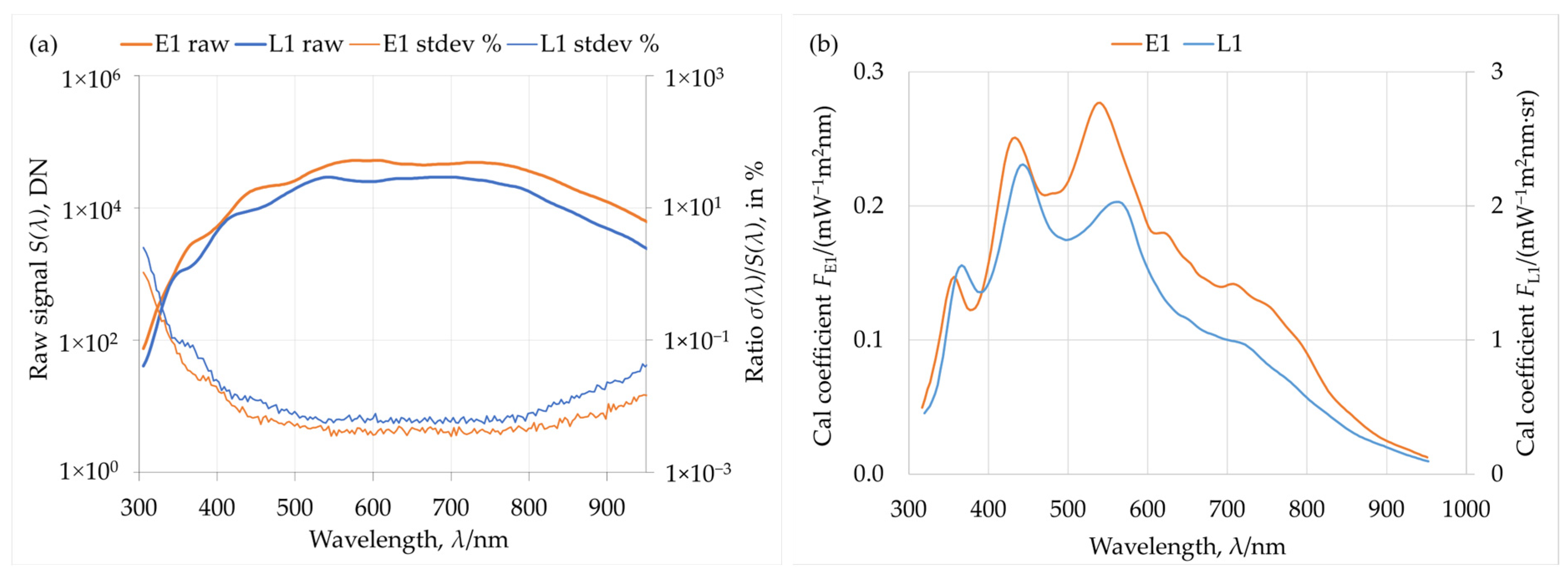




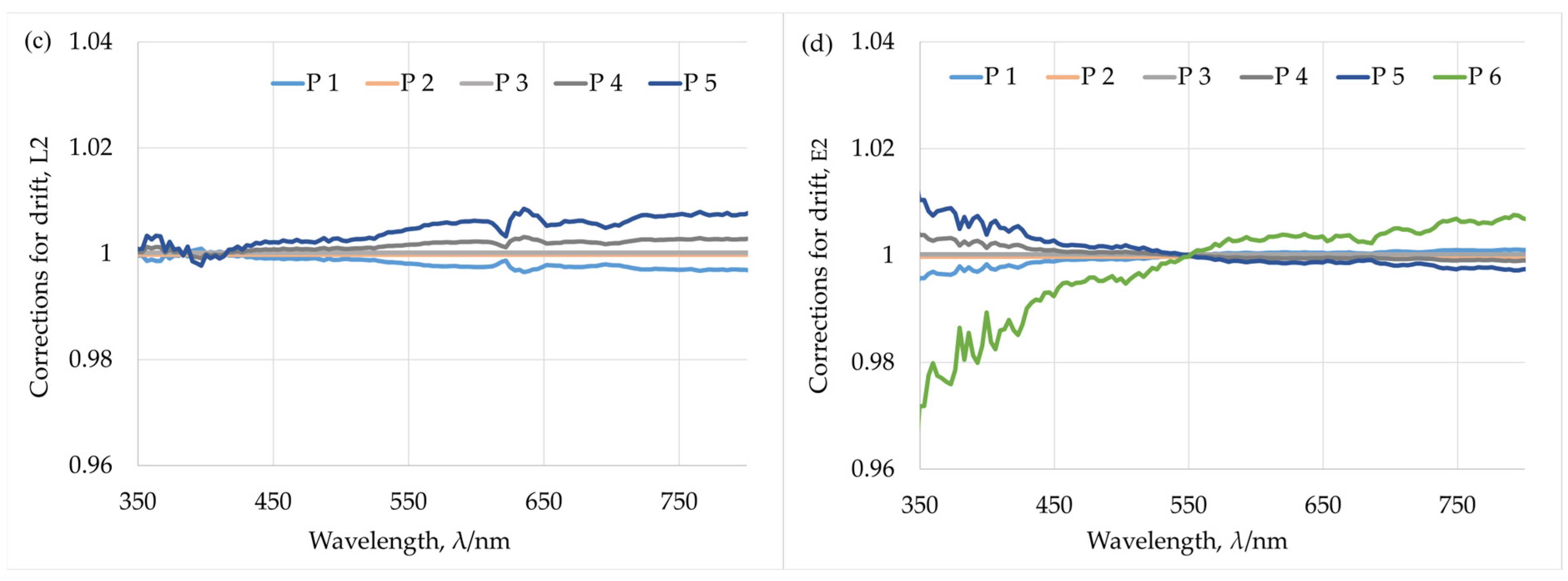
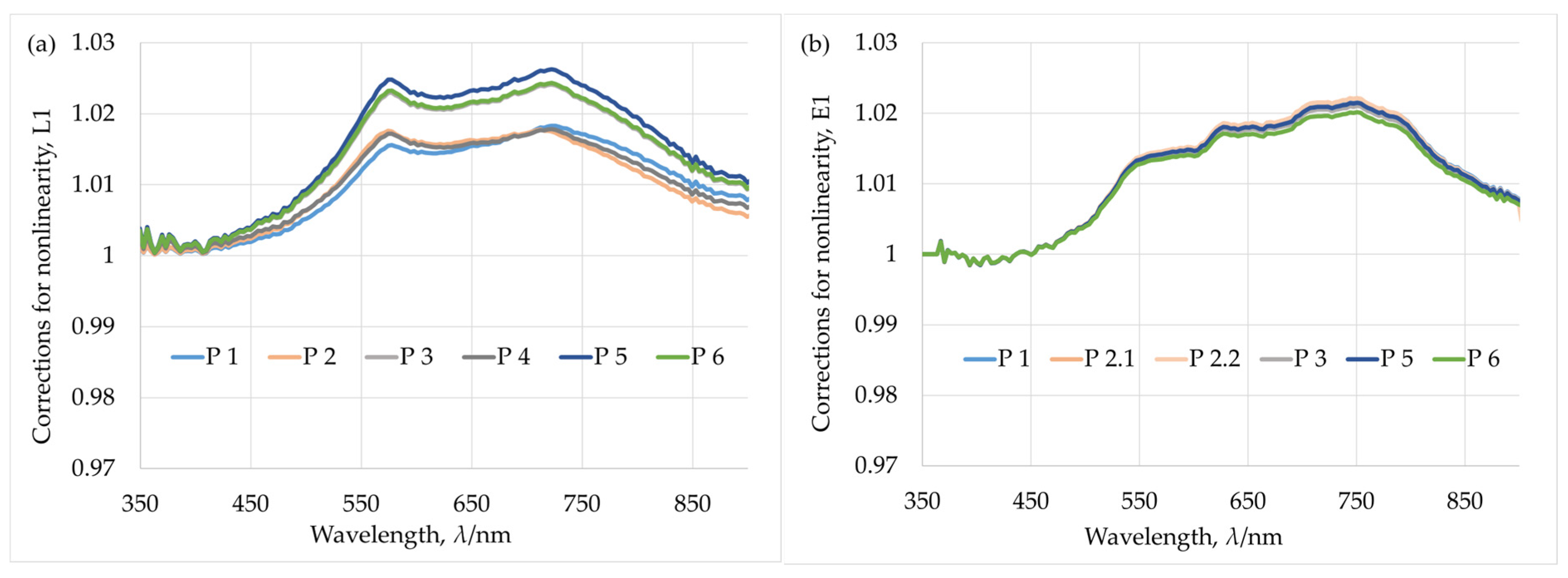
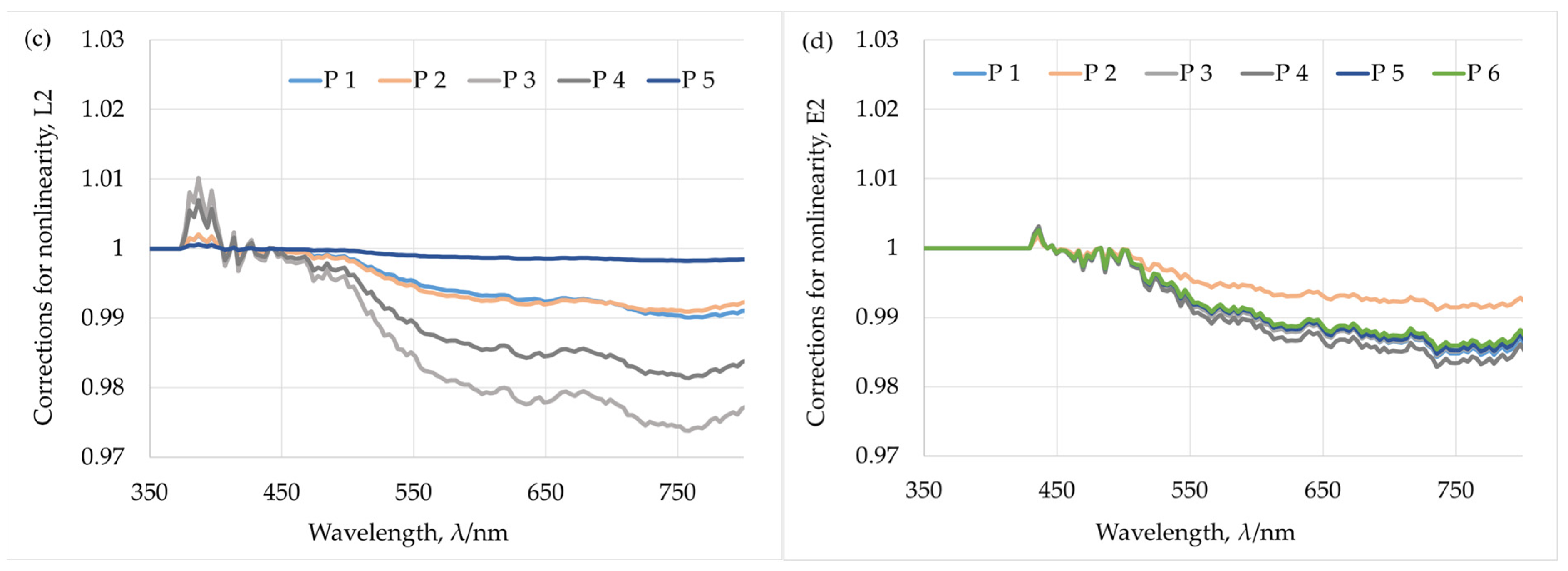

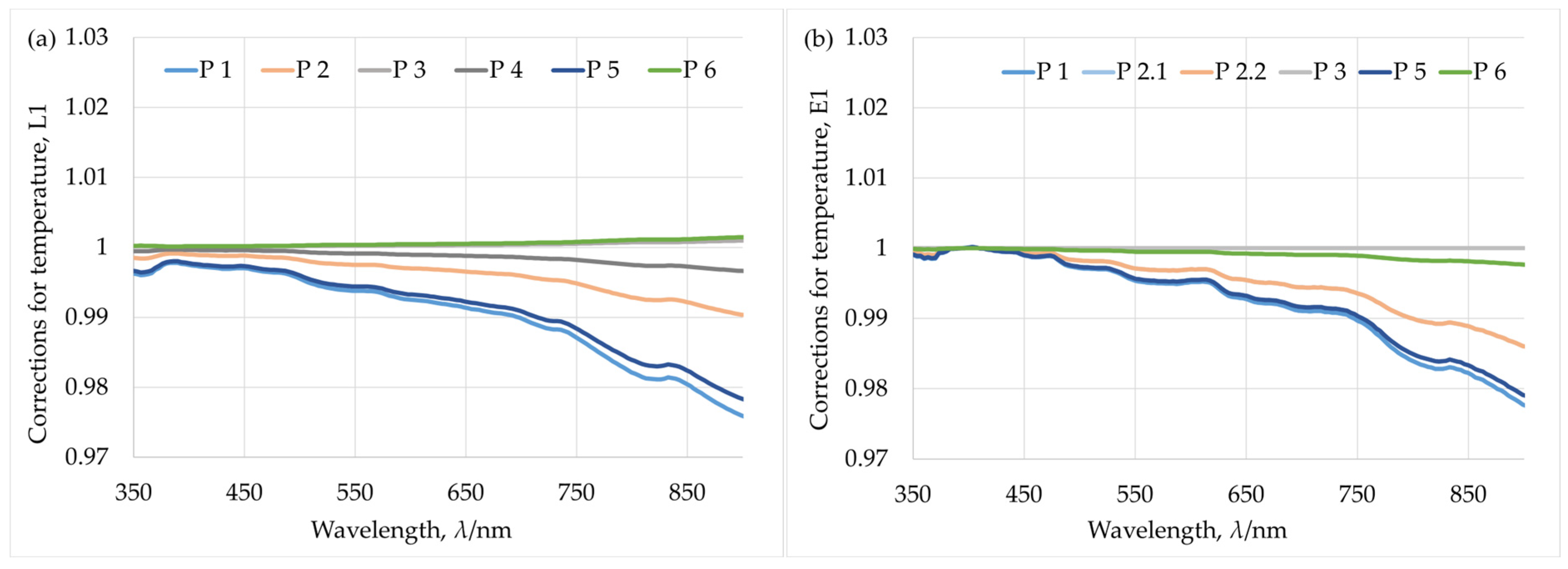

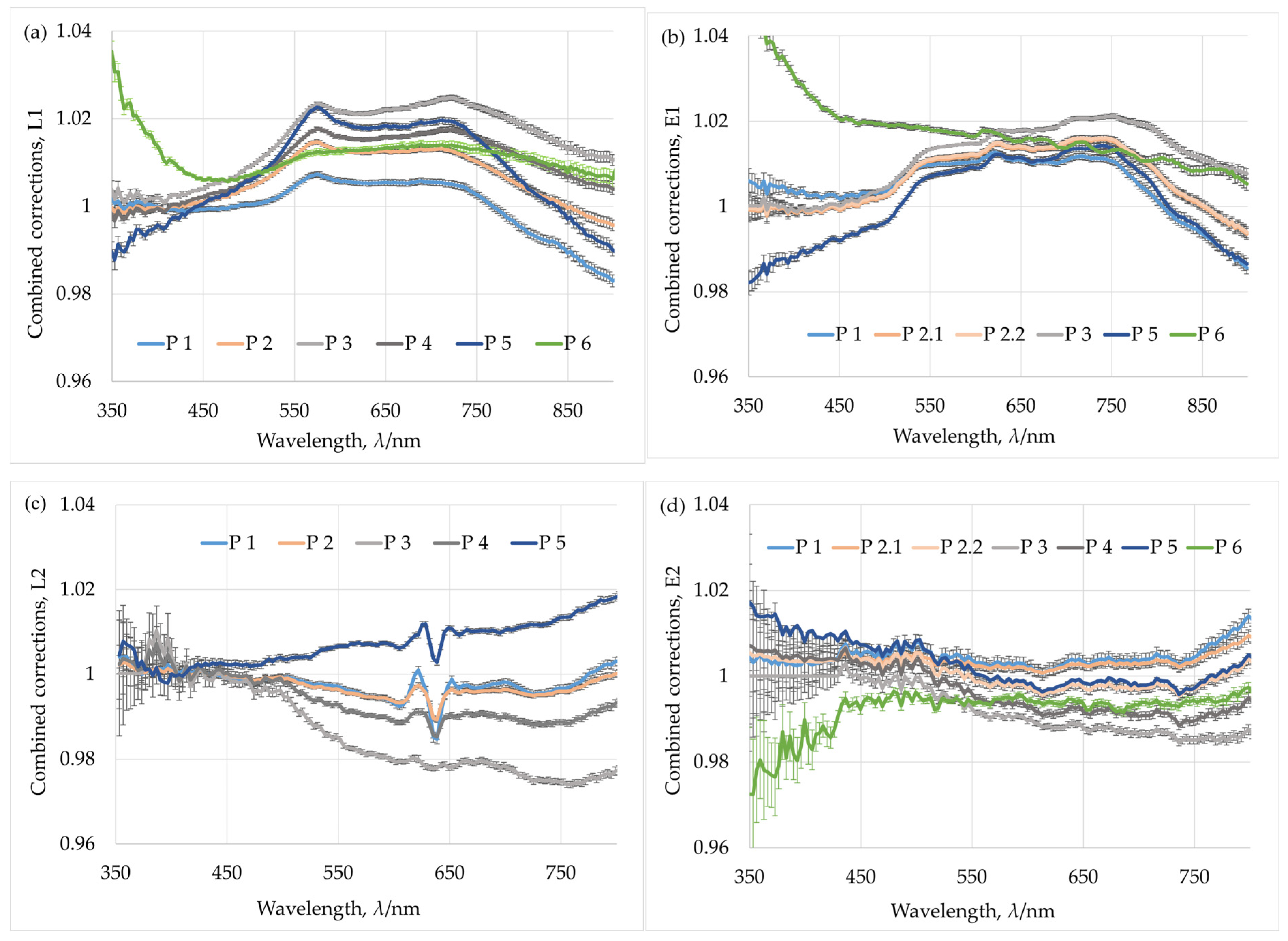

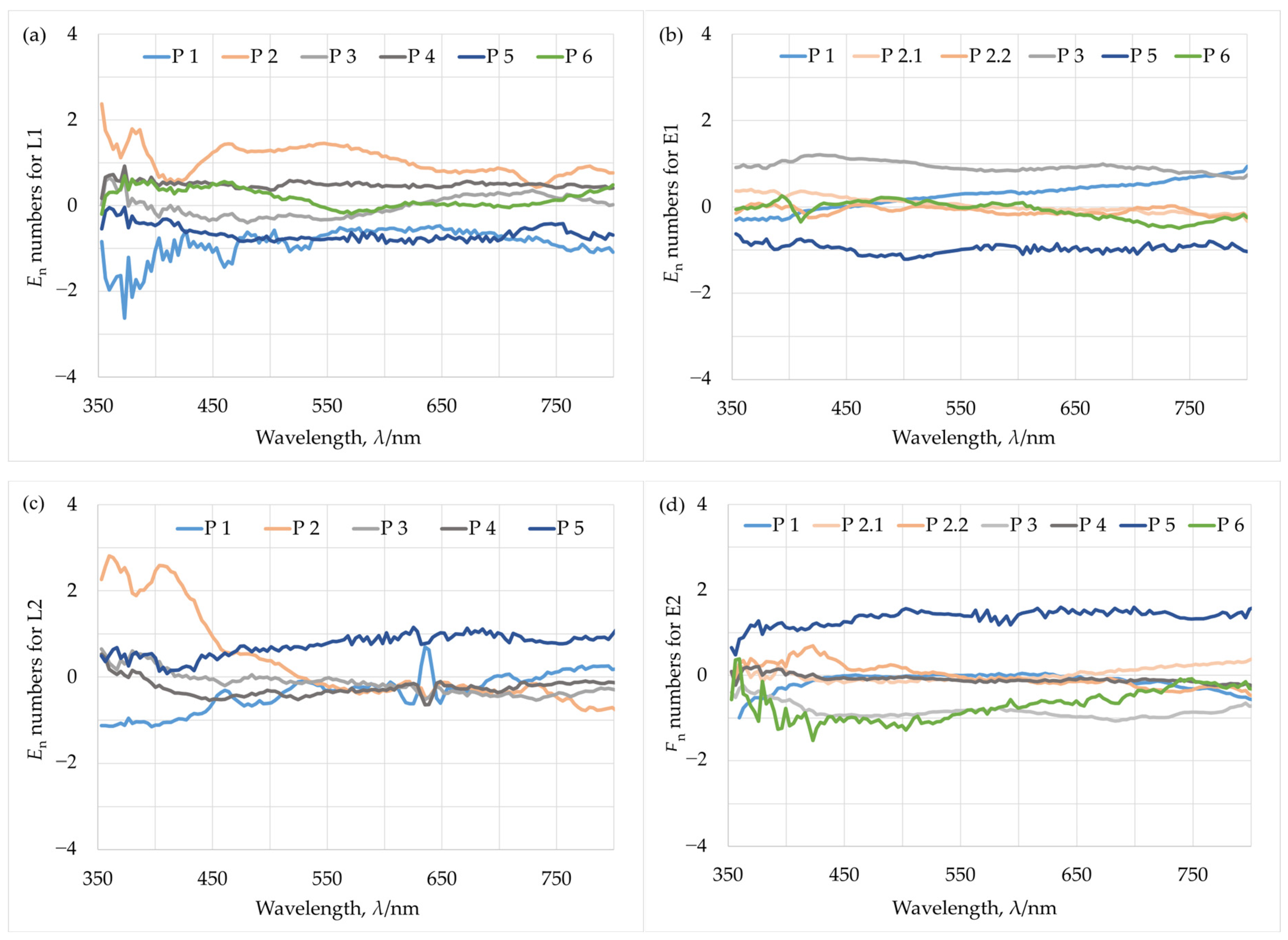
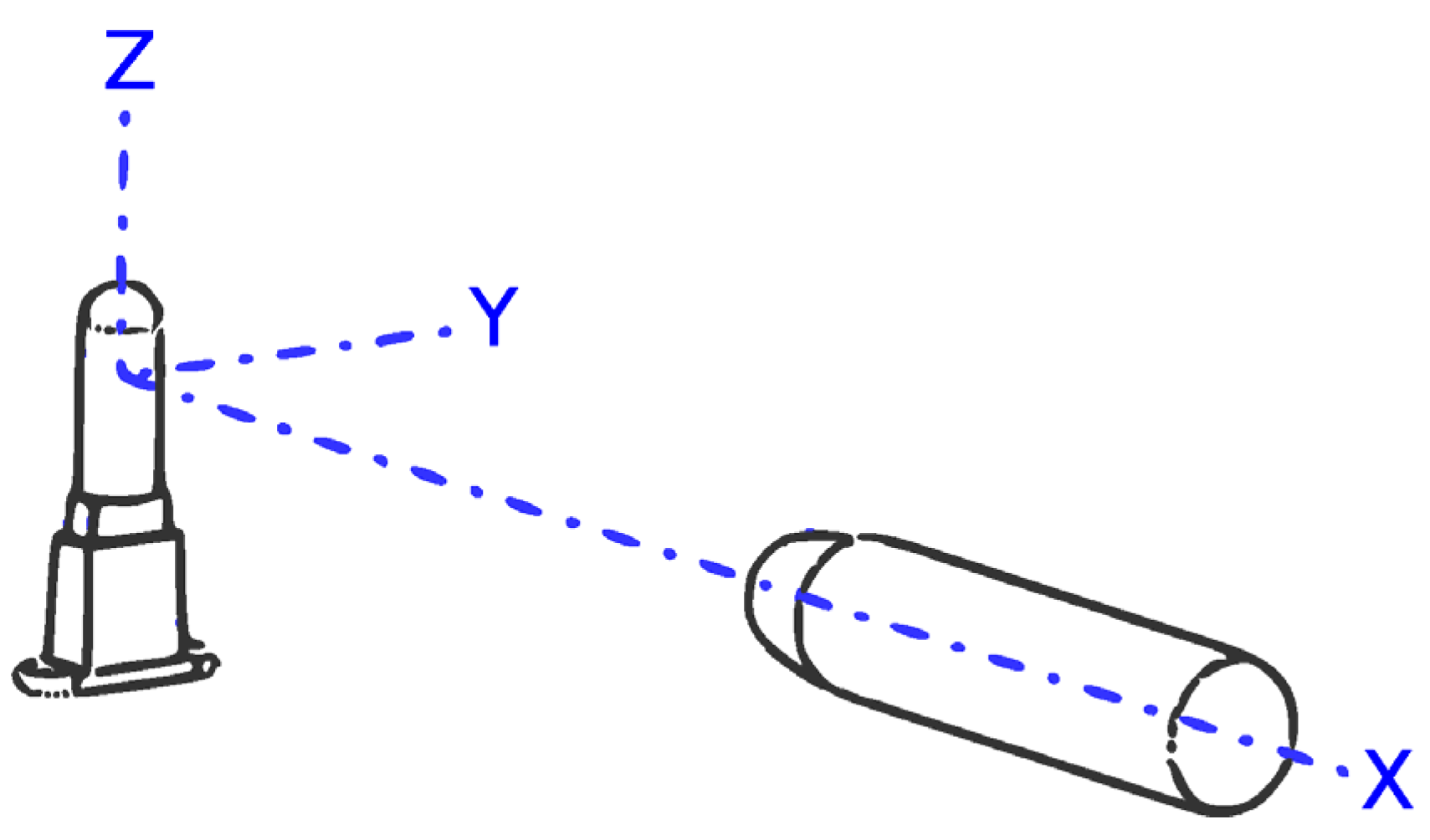
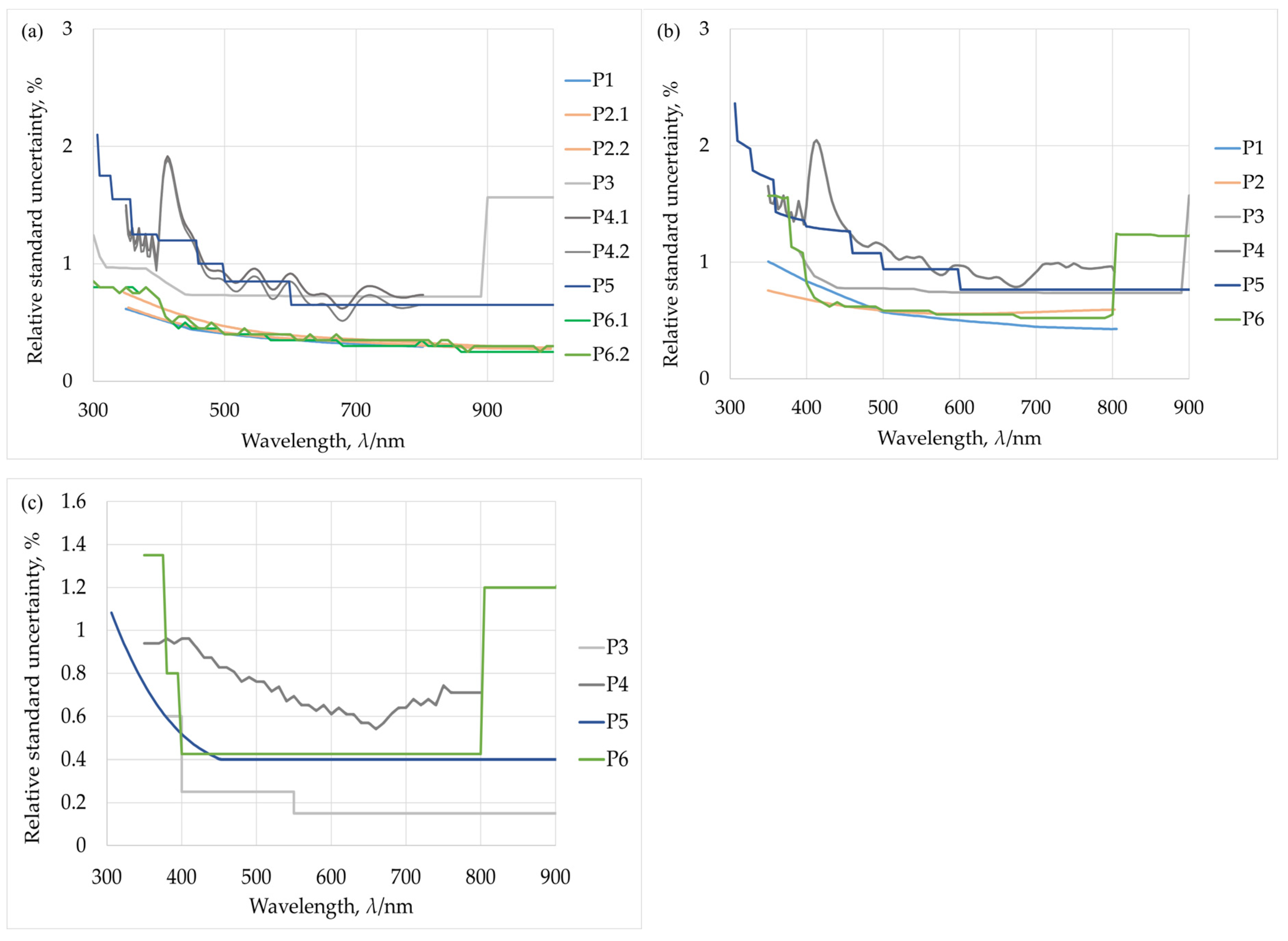
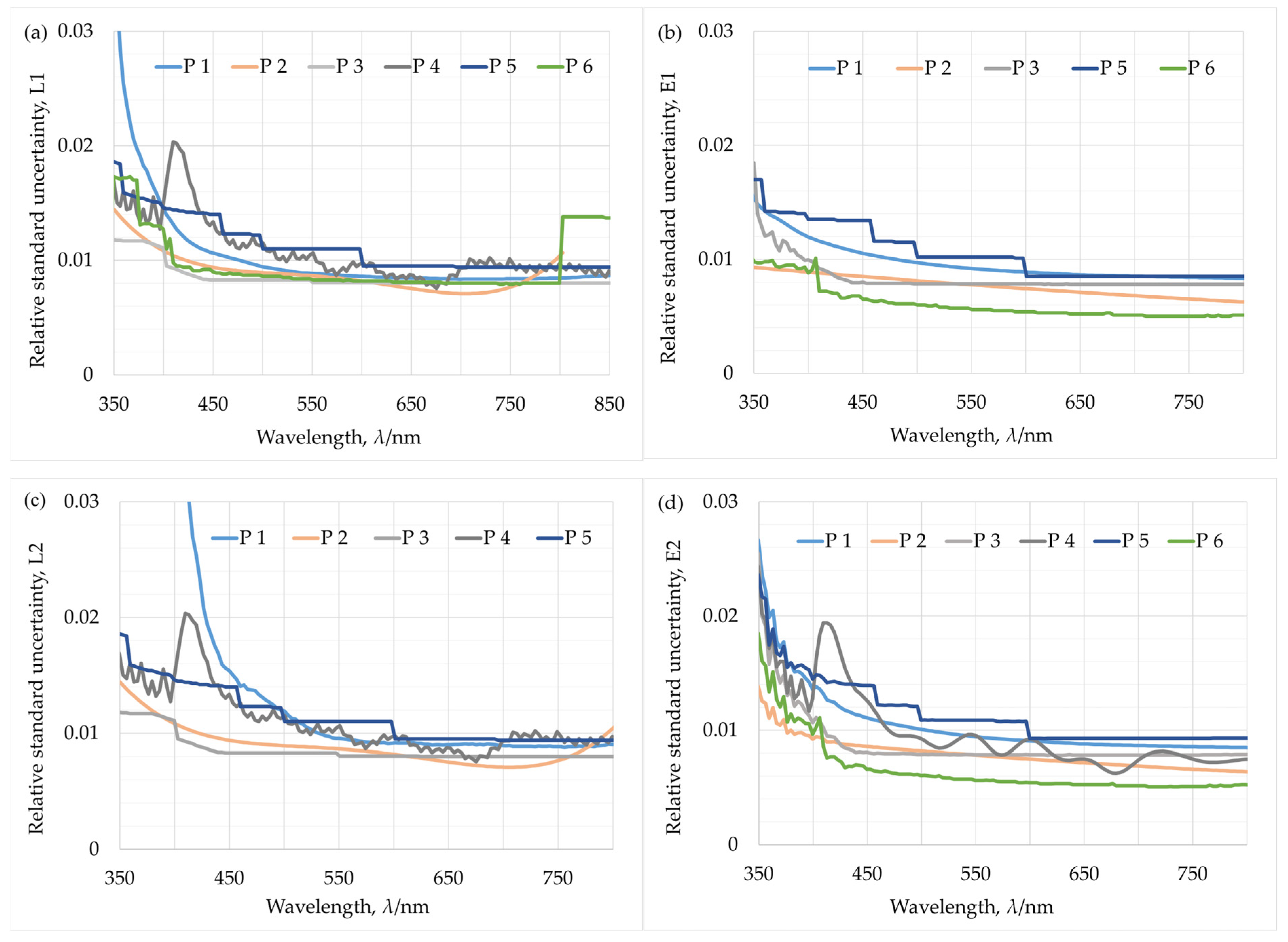
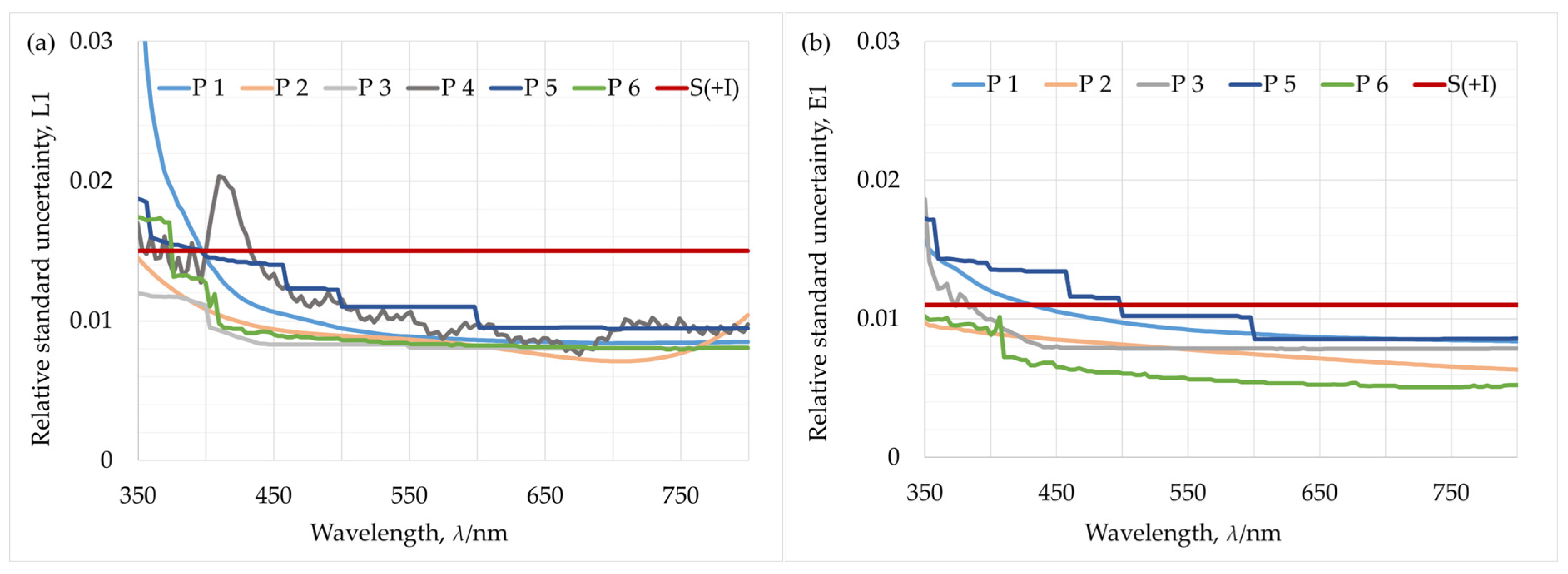


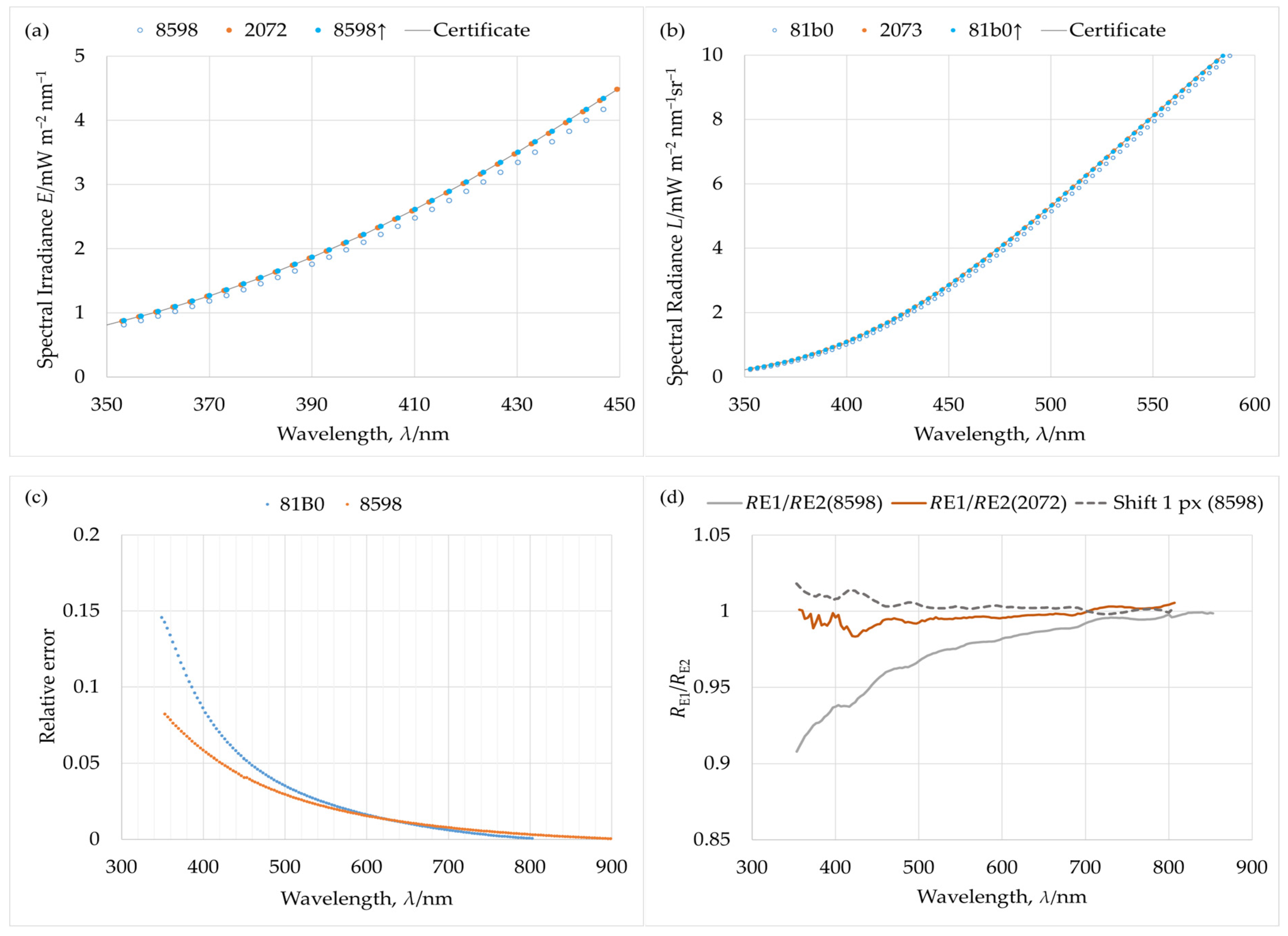



| Institute/Laboratory | Acronym | Contact Person |
|---|---|---|
| University of Tartu, Tartu Observatory (Pilot) | TO | Organization: Viktor Vabson Measurements: Ilmar Ansko |
| Norsk Institutt for Vannforskning | NIVA | Sabine Marty |
| Sea-Bird Scientific | SB | Cristina Orrico, Eric Rehm |
| Moss Landing Marine Laboratories, San Jose State University | MLML | Michael E. Feinholz, Kenneth J. Voss |
| National Oceanic and Atmospheric Administration | NOAA | Michael Ondrusek |
| National Physical Laboratory | NPL | Agnieszka Bialek, Clemens Rammeloo |
| No. | Serial Number | Manufacture Date | Function | Manufacturer | OCRs Family |
|---|---|---|---|---|---|
| 1 | SAM_81B0 | 2006 | Radiance (L) | TriOS GmbH | RAMSES |
| 2 | SAM_8598 | 2018 | Irradiance (E) | TriOS GmbH | RAMSES |
| 3 | SAT2073 | 2021 | Radiance (L) | Sea-Bird Scientific | HyperOCR |
| 4 | SAT2072 | 2021 | Irradiance (E) | Sea-Bird Scientific | HyperOCR |
| Lab | Date | Results Reported by Participants | |||
|---|---|---|---|---|---|
| RAMSES | HyperOCR | ||||
| Irradiance E1 (SAM_8598) | Radiance L1 (SAM_81B0) | Irradiance E2 (SAT2072) | Radiance L2 (SAT2073) | ||
| TO | January 2022 | Y | Y | Y | Y |
| NIVA | February–March 2022 | Y | Y | Y | Y |
| TO | April 2022 | Y | Y | Y | Y |
| Sea-Bird Sci. | June 2022 | N/A | Y | Y | Y |
| NOAA | August 2022 | Y | Y | Y | Y |
| MLML/MOBY | October 2022 | Y | Y | Y | Y |
| NPL | July 2023 | Y | Y | Y | N/A |
| TO | August 2023 | Y | Y | Y | Y |
| Participant | Standards | Measurement Distance, mm | Number of Used Int. Times | |||
|---|---|---|---|---|---|---|
| Irradiance | Radiance | Irradiance | Radiance | |||
| FEL–OCR | Integrating Sphere—OCR | |||||
| P1 | FEL | Sphere | 500 | 152.4 | 1 | |
| P2 | Two FELs | Sphere | 500 | 140 | 3–4 | |
| FEL—Panel | Panel—OCR | |||||
| P3 | Two FELs | FEL + Panel | 500 | 500 | N/A | 3 |
| P4 | Two FELs | FEL + Panel | 500 | 1300 | N/A | 3–4 |
| P5 | FEL | FEL + Panel | 500 | 1000 | N/A | 1 |
| P6 | Two FELs | FEL + Panel | 500 | 500 | 200; 250 | 3 |
| Integration Time, ms | ||||
|---|---|---|---|---|
| Participant | L1 (SAM_81B0) | E1 (SAM_8598) | E2 (SAT2072) | L2 (SAT2073) |
| P1 | 1024 | 256 | 512 | 8192 |
| P2 | 32 | 256 | 256 | 256 |
| P3 | 128 | 256 | 512 | 1024 |
| P4 | 512 | N/A | 512 | 8192 |
| P5 | 512 | 256 | 512 | 512 |
| P6 | 128 | 256 | 512 | N/A |
| Participant | Measurement Location | Temperature, °C | |||
|---|---|---|---|---|---|
| L1 (SAM_81B0) | E1 (SAM_8598) | E2 (SAT2072) | L2 (SAT2073) | ||
| P1 | Ambient | 25.7 | 26.5 | 26.2 | 26.0 |
| Device internal | 26.8 | 27.7 | 30.3 | 30.1 | |
| P2 | Ambient | N/A | 23.8–25.1 | N/A | N/A |
| Device internal | 23.3–25 | 24–24.3 | 26.3–30.0 | 26.2–26.8 | |
| P3 | Ambient | 21.5 | 21.5 | 21.5 | 21.5 |
| Device internal | 23.5 | 22.8 | 24.3–24.5 | 23.5–24.5 | |
| P4 | Ambient | 21.9–22.4 | N/A | 22.6–23.1 | 22.9–23.1 |
| Device internal | N/A | N/A | 26.3–27.2 | 26.8–27.3 | |
| P5 | Ambient | 26 | 26 | 26 | 26 |
| Device internal | N/A | N/A | N/A | N/A | |
| P6 | Ambient | 21.5–21.8 | 21.3–22.1 | 21.5–22.1 | N/A |
| Device internal | 22–22.3 | 21.3–21.7 | 24.1–25.1 | N/A | |
Disclaimer/Publisher’s Note: The statements, opinions and data contained in all publications are solely those of the individual author(s) and contributor(s) and not of MDPI and/or the editor(s). MDPI and/or the editor(s) disclaim responsibility for any injury to people or property resulting from any ideas, methods, instructions or products referred to in the content. |
© 2025 by the authors. Licensee MDPI, Basel, Switzerland. This article is an open access article distributed under the terms and conditions of the Creative Commons Attribution (CC BY) license (https://creativecommons.org/licenses/by/4.0/).
Share and Cite
Vabson, V.; Ansko, I.; Bialek, A.; Feinholz, M.E.; Kuusk, J.; Lamb, R.; Marty, S.; Ondrusek, M.; Rammeloo, C.; Rehm, E.; et al. Laboratory Calibration Comparison of Hyperspectral Ocean Color Radiometers in the Frame of the FRM4SOC Phase 2 Project. Remote Sens. 2025, 17, 3692. https://doi.org/10.3390/rs17223692
Vabson V, Ansko I, Bialek A, Feinholz ME, Kuusk J, Lamb R, Marty S, Ondrusek M, Rammeloo C, Rehm E, et al. Laboratory Calibration Comparison of Hyperspectral Ocean Color Radiometers in the Frame of the FRM4SOC Phase 2 Project. Remote Sensing. 2025; 17(22):3692. https://doi.org/10.3390/rs17223692
Chicago/Turabian StyleVabson, Viktor, Ilmar Ansko, Agnieszka Bialek, Michael E. Feinholz, Joel Kuusk, Ryan Lamb, Sabine Marty, Michael Ondrusek, Clemens Rammeloo, Eric Rehm, and et al. 2025. "Laboratory Calibration Comparison of Hyperspectral Ocean Color Radiometers in the Frame of the FRM4SOC Phase 2 Project" Remote Sensing 17, no. 22: 3692. https://doi.org/10.3390/rs17223692
APA StyleVabson, V., Ansko, I., Bialek, A., Feinholz, M. E., Kuusk, J., Lamb, R., Marty, S., Ondrusek, M., Rammeloo, C., Rehm, E., Vendt, R., Voss, K. J., Gossn, J. I., & Kwiatkowska, E. (2025). Laboratory Calibration Comparison of Hyperspectral Ocean Color Radiometers in the Frame of the FRM4SOC Phase 2 Project. Remote Sensing, 17(22), 3692. https://doi.org/10.3390/rs17223692








